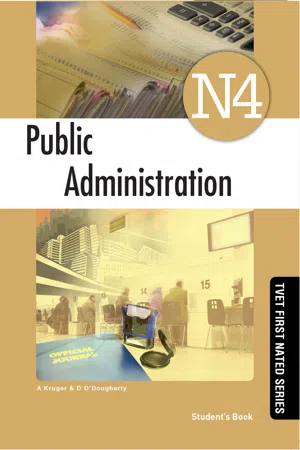
This is a test
- English
- PDF
- Available on iOS & Android
eBook - PDF
Book details
Table of contents
Citations
About This Book
Equips students with all the knowledge and skills they need to fill local, provincial and national roles in the public sector.Plenty of activities modelled on exam questions to prepare students for exam success.Uses mind maps to help students understand and connect key concepts.
Frequently asked questions
At the moment all of our mobile-responsive ePub books are available to download via the app. Most of our PDFs are also available to download and we're working on making the final remaining ones downloadable now. Learn more here.
Both plans give you full access to the library and all of Perlego’s features. The only differences are the price and subscription period: With the annual plan you’ll save around 30% compared to 12 months on the monthly plan.
We are an online textbook subscription service, where you can get access to an entire online library for less than the price of a single book per month. With over 1 million books across 1000+ topics, we’ve got you covered! Learn more here.
Look out for the read-aloud symbol on your next book to see if you can listen to it. The read-aloud tool reads text aloud for you, highlighting the text as it is being read. You can pause it, speed it up and slow it down. Learn more here.
Yes, you can access Public Administration N4 SB by D O'Dougherty & A Kruger in PDF and/or ePUB format, as well as other popular books in Business & Business General. We have over one million books available in our catalogue for you to explore.
Information
Table of contents
- Front cover
- Title page
- Imprint page
- Contents
- Module 1: Introduction to public administration
- Unit 1.1: The environment of public administration
- Unit 1.2: The unique character of the environment –legislative, executive, judicial and administrative institutions
- Unit 1.3: The difference between public administration and administration
- Unit 1.4: Public responsibility
- Unit 1.5: The role players that influence political decisions
- Module 2: The development of the family, community and state
- Unit 2.1: How families can lead to the development of communities
- Unit 2.2: Communities begin when families join
- Unit 2.3: From community to state
- Module 3: Democratic principles as guidelines
- Unit 3.1: What is democracy?
- Unit 3.2: Guaranteeing the human rights of citizens
- Unit 3.4: Government by the people
- Unit 3.5: The division of the authority of the state
- Unit 3.6: Order and welfare functions
- Module 4: The right to vote and citizenship
- Unit 4.1: Citizenship
- Unit 4.2: The right to vote
- Unit 4.3: How voters register for elections
- Unit 4.4: How are voters’ regions and districts divided?
- Unit 4.5: Candidates for voters’ regions
- Unit 4.6: Voting systems
- Unit 4.7: What happens on an election day?
- Module 5: Hierarchy ofauthorities
- Unit 5.1: Interim government and Interim Constitution
- Unit 5.2: Central authority
- Unit 5.3: Regional government
- Unit 5.4: Local authorities
- Unit 5.5: Traditional authorities
- Unit 5.6: The Volkstaat Council
- Module 6: Legislative authorities
- Unit 6.1: Legislative authority at national level
- Unit 6.2: Legislative authority at provincial level
- Unit 6.3: Legislative authority at local level
- Module 7: Executive authority at the three levels of government
- Unit 7.1: Political executive authority at national level
- Unit 7.2: Executive authority at provincial level
- Unit 7.3: Executive authority at local level
- Module 8: Judicial authority
- Unit 8.1: Introduction to the judiciary – an independent branch of government
- Unit 8.2: The Constitutional Court
- Unit 8.3: Magistrates’ courts
- Unit 8.4: The Supreme Court of Appeal
- Unit 8.5: High courts
- Unit 8.6: Other courts
- Module 9: Executive public institutions
- Unit 9.1: Introduction to the organisation of executive bodies in South Africa
- Unit 9.2: Government departments
- Unit 9.3: Quasi-autonomous institutions
- Unit 9.4: State-owned enterprises
- Unit 9.5: Research institutions
- Unit 9.6: Control boards and commissions
- Module 10: Generic and management functions
- Unit 10.1: Introduction – generic, conceptual, managerial, auxiliary, instrumental and line functions
- Unit 10.2: Auxiliary and instrumental functions
- Unit 10.3: Line functions
- Glossary
- Mock examination paper
- Memorandum